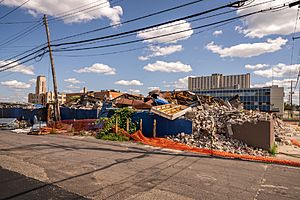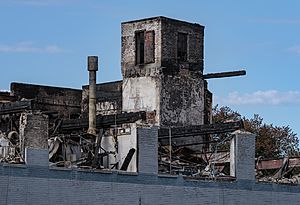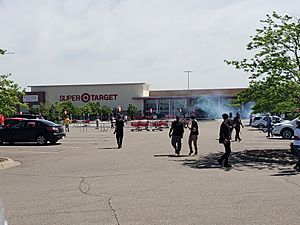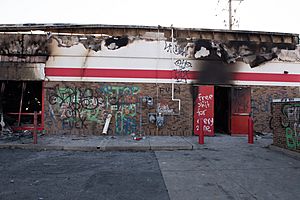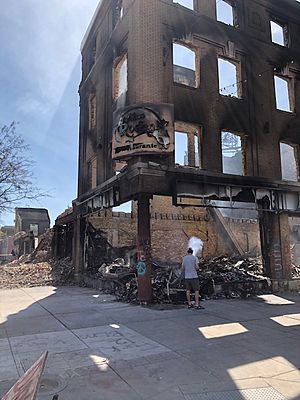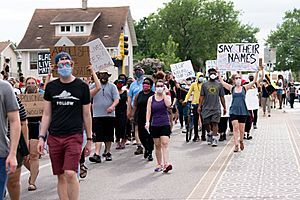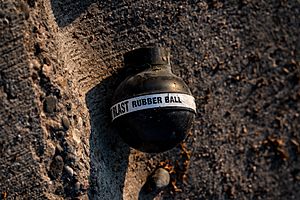Aftermath of the George Floyd protests in Minneapolis–Saint Paul facts for kids
Quick facts for kids Aftermath of the George Floyd protests in Minneapolis–Saint Paul |
|
|---|---|
| Part of George Floyd protests in Minneapolis–Saint Paul | |
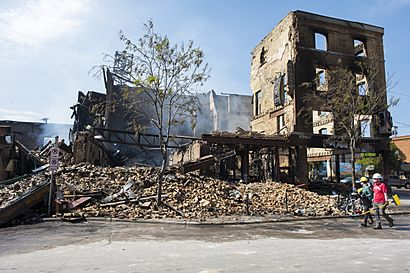
Ruins on East Lake Street, May 30, 2020
|
|
| Date | Initial period of unrest, May 26, 2020 – June 7, 2020 |
| Location | |
| Caused by | George Floyd protests |
| Methods | Riots, demonstrations, civil disobedience, civil resistance, public art |
| Status | Prolonged local unrest |
| Result | |
| Death(s) |
|
| Arrested | 604 from May 27, 2020—June 2, 2020 |
| Charged |
|
The aftermath of the George Floyd protests in Minneapolis–Saint Paul describes the result of civil disorder between May 26, 2020, and June 7, 2020, in the Twin Cities metropolitan area of the U.S. state of Minnesota. Protests began as a response to the murder of George Floyd, a 46-year-old African-American man, on May 25, 2020, after Minneapolis police officer Derek Chauvin knelt on Floyd's neck for 9 minutes and 29 seconds as three other officers assisted during an arrest. The incident was captured on a bystander's video and it drew public outrage as video quickly circulated in the news media by the following day.
Local events are sometimes referred to as the "2020 Minneapolis riots" or the "Minneapolis uprising". Protests that first emerged in Minneapolis on May 26, 2020, were initially peaceful. A several-day period of civil unrest, particularly three nights of heavy rioting from May 27, 2020, to the overnight hours of May 29, 2020, however, resulted in an estimated $500 million of damages to 1,500 property locations, 604 arrests, 164 instances of arson, and 2 riot-related deaths. Minnesota Governor Tim Walz deployed the state's National Guard to quell civil disorder and protests over Floyd's murder returned to being mostly peaceful events after May 30, 2020. The state government’s command that responded to the initial unrest after Floyd's murder demobilized on June 7, 2020, as protests and intermittent civil disorder over racial injustice persisted throughout 2020 and 2021.
Video footage of Floyd's murder and media coverage of the initial events in Minneapolis inspired a global protest movement against police brutality and racial inequality. The initial period of local unrest in Minneapolis, Saint Paul, and metropolitan suburban communities was the second most destructive in United States history, after the 1992 Los Angeles riots. By early June 2020, the events in Minneapolis and Saint Paul had been overlooked by national media as attention shifted to events elsewhere, but local residents and officials were left mired in the aftermath of historic unrest and property destruction amid an ongoing racial reckoning.
Investigations of demonstrators, police tactics, and the government response to civil unrest were ongoing in 2022.
Contents
Background
Protests and riots
Property damage
Arson, vandalism, and looting
In the days after George Floyd's murder, nearly 1,500 property locations in the Twin Cities were damaged by vandalism and looting, and dozens of others were completely destroyed by fire with some sites reduced to piles of rubble. Rioters in dense stretches of the cities smashed doors and windows of store fronts, covered surfaces with graffiti, vandalized structures, ransacked stores, and stole merchandize. Many stores were looted repeatedly over several days. The heaviest damage in Minneapolis occurred along a 5-mile (8.0 km) stretch on Lake Street between the city's third and fifth police precinct stations and in Saint Paul along a 3.5-mile (5.6 km) stretch of University Avenue in the Midway area. During the riots, Minnesota National Guard forces and law enforcement focused on protecting large institutions such as the Federal Reserve, power plants, and state capitol building. Officials acknowledged the emphasis on strategic targets came at the expense of family- and minority-owned business, many of which were burned or plundered by looters.
In Minneapolis, approximately 1,300 properties were damaged by the rioting and looting, nearly 100 of which were destroyed or severely damaged. Property damages, which did not include loss of business inventory, were approximately $107 million, according to the Minneapolis Assessor's Office. Overall, the city estimated damages and losses were $350 million and affected 22,000,000 square feet (2,000,000 m2) of commercial property. Three post office branches of the United States Postal Service were among the properties destroyed by fire during the riots. Thirty-five families lost their housing in buildings that were damaged by fire.
In Saint Paul, the unrest resulted in $82 million in damages and affected 330 buildings. The total dollar amount of damages did not include other long-term impacts such as lost business activity. Thirty-seven properties sustained major damage or were destroyed, about half of which were national chain stores. During the heaviest period of unrest, Saint Paul's fire department responded to 50 confirmed structure fires. The city's University Avenue corridor that sustained most of the damage featured many small businesses owned by people of color. More than 50 damaged business were owned by Asian-American people, some of whom resettled in the area after leaving war-torn countries. Many of those later charged federally for arson crimes were white Americans. Commenting on the racial dynamic, the St. Paul Pioneer Press said, "In St. Paul, the irony of self-proclaimed advocates — many of them white — arriving from outside the city to burn down large strips of ethnic neighborhoods in the name of racial justice hasn’t been lost on residents of the Midway."
| Type | Number damaged |
|---|---|
| Restaurant |
267
|
| Retail |
207
|
| Services |
114
|
| Grocery |
85
|
| Cellphone store |
76
|
| Fuel |
63
|
| Auto |
60
|
| Residence |
53
|
| Salon/barber |
52
|
| Health care |
47
|
A database maintained by the Star Tribune newspaper found that restaurants were the property type suffering the greatest amount of damage, with 267 locations affected by the civil disorder. Many restaurant buildings were entirely destroyed by fire during the violence, including both locally owned, independent restaurants and several locations of fast-food chains such as Arby's, Domino's Pizza, Popeyes, Subway, and Wendy's.
Damage from rioting was reported in the suburban cities as far north as Blaine and as far south as Apple Valley. Clusters of damaged storefronts also appeared in the suburban cities of Richfield, North Saint Paul, Maplewood, Brooklyn Center, and Roseville. Estimates of property damage in the region were upwards of $500 million, making the unrest in the Minneapolis-Saint Paul area the second most destructive in United States history, after the 1992 Los Angeles riots. Local officials estimated that rebuilding damaged business corridors in the Minneapolis-Saint Paul region could take 10 years.
Rebuilding and recovery
Economic conditions for people and businesses worsened in Minneapolis and Saint Paul after the riots. Local and minority-owned business were disproportionately affected by both the COVID-19 pandemic and the unrest after the murder of Floyd. Private insurance covered about 40%, less than half, of the estimated $500 million in property damages. Many businesses that were damaged or destroyed lacked insurance or were under insured to recover loses. Residents and business owners worried that outside investors would seek to displace local businesses during the rebuilding process.
Governor Walz requested federal aid of around $15 million, the amount potentially eligible for reimbursement to mitigate fire damage, from the Federal Emergency Management Agency on July 2, 2020. In order for the request to be approved, President Donald Trump would have needed declare a “major disaster” for the state of Minnesota. The federal government, however, denied the request a few days later, leaving the state with the difficulty of addressing the financial impacts from property damage amidst a state budget crisis caused by the COVID-19 pandemic. Trump later said at an August 18, 2020, campaign rally in Mankato, Minnesota, that he denied the aid request as "punishment" to local officials. That decision contrasted with the disaster declaration and federal aid package of $638 million President George H.W. Bush approved following the 1992 riots in Los Angeles.
State and local officials vowed to help affected businesses by creating new financing initiatives to accelerate repair and recovery efforts. In Saint Paul, the Chamber of Commerce raised $1 million for small business rebuilding grants. Saint Paul officials also established a $3 million relief fund, but it was quickly depleted and officials looked to state and federal relief options by August 2020. The Lake Street Council had raised $12 million for distribution as small grants to help local business rebuild and recover in the East Lake Street corridor in Minneapolis that had been most impacted by arson and looting.
By August 2020, the vast majority of the heavily damaged sites were still left in ruins or dangerous piles of hazardous rubble as the city required business owners to be fully compliant with property taxes before issuing demolition permits. Frustrated and financially distressed business owners felt the city was discouraging reinvestment, especially as Saint Paul officials expedited demolition permits without a similar requirement. Minneapolis officials eventually waived the property tax requirement after the issue generated public scrutiny.
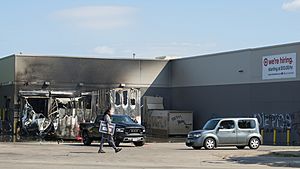
Several large businesses announced immediate plans to rebuild after the riots. Among them, the Target Corporation made a commitment to rebuild the store on East Lake Street that had been heavily damaged and looted, which it re-opened six months later in November 2020, and was followed by the re-opening of nearby stores Aldi, Family Dollar, and Cub Foods that had to be heavily renovated. The developer of Midtown Commons, the six-story, under-construction affordable housing building that burned down near the third precinct station, announced plans in June to start the project over, a process the developer said would take two years.
Many small business owners in the Twin Cities who were affected by the riots and looting found they had to pay for repairs and rebuilding out of their own pockets as insurance payments fell well short of amounts needed. A proposed $300 million Minnesota recovery fund, that included $168 million for small businesses and nonprofits to rebuild, did not receive backing from the state legislature in 2020 when Republicans who controlled the Minnesota Senate objected. In June 2021, state lawmakers agreed to a $150 million small business relief program, but it require businesses to seek an up-front, 2-to-1 match. It was also available to any business in the state for economic recovery and not focused on businesses affected by the riots in Minneapolis and Saint Paul. By the end of 2021, no business damaged during the unrest had received any state aid or loans. Only about $20 million of the state funds were earmarked for Minneapolis and $7 million for Saint Paul for rebuilding from the May 2020 riots. In Minneapolis, the communities along the Lake Street corridor, West Broadway in North Minneapolis, and the area around 38th and Chicago were the only ones eligible for the state funds.
The recovery process for many of the small, independent businesses that burned down near the third police precinct station at Lake Street and Minnehaha Avenue was described as slow. The owner of the Gandhi Mahal Restaurant near Minnehaha Avenue who famously said, “Let my building burn. Justice needs to be served,” during the initial riots, became an international symbol of the unrest. However, six months later he was left paying for $80,000 in demolition costs out of pocket and was worried about his future. Demolition costs for many properties were between $200,000 to $300,000, which was more than the buildings were worth before being burned down. In August 2020, the City of Minneapolis agreed to demolish some properties and passed on the assessed cost to property owners; a $2 million hardship fund was set up for property owners that could not pay. Four months later the city had little to show for the efforts as some of the ugliest and most hazardous piles of rubble remained. The owners of Town Talk diner on East Lake Street sued the city for $4.5 million. The landmark restaurant burned down on May 28, 2020, after police vacated the third police precinct building and abandoned the East Lake Street area.
Some businesses said they would not rebuild and would disinvest from Minneapolis. One business that suffered heavy damage to its factory from the fires, 7-Sigma, which was located near the third police precinct building, said they would leave the city for good after losing trust in public officials during the riots. The restaurant chain Arby's said it would wait to rebuild its location that burned on East Lake Street near Hiawatha Avenue, citing the potential for unrest over the trial verdict of the four police officers responsible for Floyd's murder.
At about a year after the May 2020 riots, less than 5 percent of the businesses that were damaged or destroyed on East Lake Street in Minneapolis had reopened, according to the Lake Street Council that promoted business activity in the area. In Saint Paul, 35 of the 270 businesses damaged during the riots remained closed a year after the riots. The Midway Chamber of Commerce distributed aid to damaged business ranging from $1,000 to $50,000 from the $1 million it raised to support affected store owners. The Midway Shopping Center on University Avenue, which was damaged by fires and looting on May 28-29, 2020, permanently closed as Saint Paul city officials ordered it demolished, which resulted in several minority-owned businesses within the shopping center being forcefully closed that did not suffer fire damage to their storefront during the riots.
Deaths
Calvin Horton Jr.
Calvin Horton Jr., a 43-year-old man from Minneapolis, was fatally shot on May 27, 2020, by the owner of the Cadillac Pawn & Jewelry shop who believed he was burglarizing his business. The incident took place on East Lake Street about one mile (1.6 km) from the main protest site that evening. The owner of the shop was a 59-year-old man from Galesville, Wisconsin. The scene in and around the store was described as chaotic with many people inside the store. When police officers arrived in response to the shooting, bystanders threw objectors at the officers as they administered aid to Horton, Jr. and attempted to investigate the scene, leading the officers abort the investigation. Paramedics that arrived were unable to reach Horton on the sidewalk due to the chaos until officers moved him to a nearby business. Horton died that night at a hospital.
The shop owner was arrested the night of the shooting and held in Hennepin County Jail for several days, but he was released pending further investigation. One witness said Horton was within seven feet (2.1 m) of the shop owner when he was shot. The Hennepin County Medical Examiner found Horton was turned sideways. Several other witnesses who were at the scene refused to cooperate with investigators, including a friend of Horton's and the pawn shop owner. Authorities were unable to recover the firearm used in the shooting or surveillance footage as the store was ransacked the night of the shooting and everything was taken when by the time officers returned to investigate the next day.
There were no new developments in the case by July 21, 2020, when family and supporters of Horton, Jr. protested outside the store and demanded the owner be charged with murder. In December 2020, Hennepin County Attorney Mike Freeman's office declined to file charges against the pawn shop owner after a six-month investigation due to a lack of evidence to prove the shooting was not self-defense.
Oscar Lee Stewart Jr.
Oscar Lee Stewart Jr., a 30-year-old man from Burnsville, Minnesota, died on May 28, 2020, in a fire that destroyed the Max It Pawn shop on East Lake Street in Minneapolis. His remains were recovered by federal and state authorities on July 20 and his identity revealed the following October. The Hennepin County Medical Examiner's office classified his death as a homicide due to inhalation and thermal injuries sustained in an intentional building fire. The Max It Pawn shop was located a few blocks east of the third precinct station in an area of heavy rioting. Montez T. Lee Jr., 25-year-old man from Rochester, Minnesota, was federally charged in June 2020 with arson for the particular fire.
Two days after Floyd's murder, on May 28, 2020, Stewart Jr. had called his family to say was going to stop by Lake Street to see the protests. He did not return home that evening. Over the ensuing weeks, his family filed a missing persons report and conducted a search of its own for Stewart, and eventually tracked his car's GPS to behind the pawnshop. It was not until authorities discovered human remains at the pawn shop in July, and later matched his DNA, that Stewart's whereabouts were known. Videos from the night of May 28, 2020, revealed a frantic search for a person trapped inside the pawn shop as it burned. Bystanders had tried to remove plywood panels from the exterior of the building when they heard faint cries for help from inside. The cries had stopped when firefighters arrived at the scene and found the building engulfed in flames. Firefighters were unable to conduct a sweep due to the deteriorating conditions. Family members of Stewart questioned why it took authorities nearly two months to search the wreckage again to find his remains.
In July 2021, Montez T. Lee Jr. pled guilty to one federal count of arson for his actions on May 28, 2020, that included pouring an accelerate around the business and setting it on fire. Lee, along with others, broke into the pawn shop, and Lee's actions were captured by surveillance video. Lee was not specifically prosecuted for Steward's death and his attorney disputed that he was responsible stating that Lee believed that the pawn shop was empty when he set it on fire. Prosecutors in the federal arson case against Lee requested leniency in his prison sentence as they did not believe he intended to hurt anyone when he started the fire.
Agitators and extremist involvement
Official speculation
Early in the events, state and local officials claimed that "white supremacists" and "outside agitators" might be responsible for property destruction and violence. Walz initially speculated that as much as 80% of people causing destruction and lighting fires could be from outside the state; several analyses of arrest records later contradicted the statement, finding that under 20% of those arrested were from outside Minnesota. Mayor Melvin Carter said that all of the people arrested in Saint Paul by May 30 were from outside Minnesota, a claim he later rescinded. President Donald Trump and U.S. Attorney General William Barr placed blame for the riots on radical leftists and the Antifa movement, but an investigation by the FBI later revealed no such trend among those found responsible for the violence and destruction.
Hacked police intelligence documents as part of the BlueLeaks data release revealed that federal and state officials were monitoring social media and online message groups for extremist activity related to the protests. Local law enforcement were on high alert for suspicious behavior and attacks on officers, possibly leading to confrontational tactics with demonstrators, such as firing less-lethal munitions and tear gas. A number of imminent attack warnings officials were secretly monitoring never came to pass. Federal, state, and local officials refused to comment on the documents, saying they were obtained illegally and contained law enforcement-sensitive information.
The FBI believed that much of the damage in Minneapolis and Saint Paul was caused by unaffiliated, opportunistic crowds that amassed spontaneously, rather than by extremist actors. However, some white supremacist groups discussed exploiting the events to incite racial violence, and federal officials later prosecuted several Boogaloo movement members for crimes committed during or after the riots in Minneapolis.
"Umbrella Man"
A person, nicknamed "Umbrella Man", who dressed in black clothing, wore a gas mask, and carried an umbrella and small sledgehammer, was seen in a bystander's video taken on May 27, 2020, breaking windows at an AutoZone store near the third police precinct, as well as spray-painting on the store. He also made violent threats to a photojournalist who captured images of him in the background of a news report. Later that day, the AutoZone store was set on fire by unknown people. Videos of the AutoZone windows being smashed were later circulated widely on social media.
In late July 2020 the Minneapolis police department identified a suspect for "Umbrella Man". The suspect had ties to the Hells Angels and Aryan Cowboy Brotherhood (a neo-Nazi prison gang and organized crime gang), and he participated in the harassment of a Muslim woman in Stillwater, Minnesota, in June 2020 that received media coverage. Police documents that were leaked to the public stated that white supremacist groups, including the Hells Angels and Aryan Cowboys, had discussed discrediting protests by posing as demonstrators. Minneapolis police obtained a cellphone search warrant in June 27, 2020, to examine geolocation data. The person had not been charged with any crime as of December 2020. By mid 2021, the Minneapolis police refused to comment on "Umbrella Man" or new developments as they considered the matter to be an open investigation.
Boogaloo movement
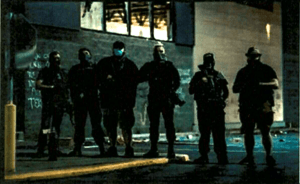
During the days of initial unrest that followed Floyd's murder on May 25, 2020, adherents of the Boogaloo movement, a loosely organized far-right antigovernmental extremist ideology, discussed how to further chaos leading to a civil war that it hoped would be blamed on the Black Lives Matter movement. Three Boogaloo movement members were later convicted of federal crimes related to violent participation in the unrest with intention to cause destruction in Minneapolis. Facing charges were the 30-year-old Michael Robert Solomon of New Brighton, Minnesota, the 22-year-old Benjamin Ryan Teeter of Hampstead, North Carolina, and the 26-year-old Ivan Harrison Hunter of Boerne, Texas. According to federal prosecutors, Solomon recruited Boogaloo movement participation in the unrest via Facebook. Teeter was one of at least five Boogaloo adherents to travel to Minneapolis to join Solomon. Boogaloo movement adherents were seen openly carrying firearms in Minneapolis neighborhoods and discussed committing acts of violence against police and other targets to advance their mission to overthrow the government.
After the riots abated, Boogaloo adherents attempted to raise money to buy a training facility in South America. Solomon and Teeter connected with an FBI informant who had posed as a member of the Hamas organization, who they agreed to supply weapons to, and they also made plans to bomb a courthouse in the Twin Cities metropolitan area. Solomon and Teeter were arrested by federal agents in September 2020 before their plans were carried out. The two pled guilty to federal terrorism charges, Teeter in December 2020 and Solomon in May 2021. After providing information to assist other government cases, Solomon was sentenced in March 2022 to three in years in prison and five years of supervised release. Teeter was sentenced in June 2022 to four years in prison.
Federal authorities charged Ivan Harrison Hunter, a 26-year-old man from Boerne, Texas, with one count of interstate travel to incite a riot for shooting 13 rounds from an AK-47-style machine gun into the Minneapolis third police precinct building while people were inside, looting it, and helping to set it on fire the night of May 28. Court documents alleged that he was acting as an agent provocateur and that he travelled from Texas to Minneapolis with the intent to cause damage. Hunter had made plans with other Boogaloo movement adherents, including Benjamin Teeter, to meet at the Cub Foods store near the third precinct police station the night of May 28, and he bragged about his role in setting the police station on fire afterward via posts on Facebook and in text messages with Steven Carrillo, a suspect in the Boogaloo ambush attacks of security personnel and law enforcement officers in California in May and June 2020. Hunter described himself as a "terrorist" and said he was a leader of a local Boogaloo group in Texas. He initially entered a plea of not guilty to federal riot charges at a May 2021 judicial preceding, but he later pled guilty in September 2021. In April 2022, Hunter was sentenced to four years in prison.
Hackers and cyberattacks
The City of Minneapolis experienced an increase in cyberattacks, led by hacktivist groups, in the immediate aftermath of Floyd's murder. Instances of ransomware, cryptomining, and malware increased. Malicious actors also caused temporary outages of Minnesota statewide emergency community systems by deploying denial of service attacks.
Short-term impacts
Policing policies
Though the Minneapolis police was under intense scrutiny in the aftermath of Floyd's murder, the city struggled with how to reform the force. In mid June, the Minneapolis City Council and the Minnesota Department of Human Rights agreed to a temporary restraining order requiring Minneapolis to update its procedures to ban chokeholds and other neck restraints by police, such as the one used in the murder George Floyd. Many organizations quickly distanced themselves from the Minneapolis police force by ending formal policing relationships, led by city's school district and park board (relationship restored in 2022) and the University of Minnesota. The park board also announced changes to the park police uniforms and vehicles to distinguish them from Minneapolis police. The Minnesota state legislature passed major police reform legislation in July that banned chokeholds, established an independent commission to review police-related deaths, and required de-escalation training for officers. By late 2020, city officials announced plans to begin pilot programs for mental health response teams, violence prevention, early warning system to flag officer behavior, broader use of 3-1-1 system for theft reports, and a truth and reconciliation commission to promote racial healing. The city and police department also revisited several policies, such as limiting no-knock warrants, clarifying use of force, requiring de-escalation attempts, and more heavily involving the city's attorney office in office misconduct investigations.
A public pledge to dismantle the police that was taken at Powderhorn Park on June 7, 2020, by nine Minneapolis city council members, though it represented a veto-proof majority, did not actually disband the city's police force and details about the next steps in the process were not defined at the time. Some activists wanted to consider the idea of unarmed crisis response personnel and re-purposing the police department's $193 million annual budget for education, food, housing, and health care. Public conversation about the future of the city's police department came as Minneapolis had tallied its highest levels of violent crime in decades. In December 2020, the Minneapolis city council voted to redirect $7.7 million of the department's proposed $179 million budget to mental health crisis teams, violence prevention programs, and for civilian employees to handle non-emergency theft and property damage reports. The council placed $11.4 million of the police budget in a reserve fund that requires ad hoc council approval for police recruitment and overtime. By a narrow 7-6 margin, the council voted to keep in place the police department target level of 888 officers by 2022. The 4.5 percent shift in the police budget was considered "not nearly the sweeping change that activists and some lawmakers had demanded" after Floyd's murder and the resulting unrest.
Bob Kroll, head of the Minneapolis police officers union, was the subject of several protests. After offering support for the officers at Floyd's murder and a full investigative process, he made few substantial statements during the initial course of events. But after several days of clashes with the police and protesters, he sent a controversial email to Minneapolis rank-and-file police officers. The message criticized Frey and Walz for not containing the riots and commending the work of responding officers, and he characterized the protests as a "terrorist movement", a claim he also made about the Black Lives Matter movement in 2016. Several local officials were quick to condemn Kroll's email statement, including city council president Lisa Bender who described Kroll as "a barrier to change" of the Minneapolis police force. Several labor union leaders called for Kroll's removal, with one saying he perpetuated "a culture of violence" against the black community. In June, Arradondo announced the police department would withdraw from union contract negotiations as a first step towards police reforms, but other city officials continued to participate in negotiations.
In November 2021, a ballot measure to amend the city's charter was put before Minneapolis voters to replace the police department with a department of public safety. The establishment of a new department safety would have eliminated a required minimum number of police officers based on the city's population, and the wording of the ballot question said that it would provide a "comprehensive public health approach” that "could include" police officers "if necessary". In order to pass, the measure required support from 51% of voters. It was rejected with 80,506 or 56.2 percent of votes for "no" and 62,813 or 43.8% for "yes".
By the end of 2021, city officials had restored police funding in Minneapolis to $191 million—close to funding level prior to the resource diversion following the murder of George Floyd in 2020.
Monuments removed and names changed
As the global protest movement over Floyd's murder turned towards removing monuments and memorials with controversial legacies, a statue of Christopher Columbus at the Minnesota State Capitol building in Saint Paul was torn down by American Indian Movement demonstrators on June 10, 2020, and the Minnesota Twins removed a statue of former club owner Calvin Griffith on June 19, 2020. Residents of the Minneapolis neighborhood of East Calhoun scrutinized John C. Calhoun, the neighborhood's namesake, legacy of defending slavery, and pushed the city council to rename it East Bde Maka Ska in July 2021. In 2022, after a campaign by activists and residents, the City of Minneapolis changed the name of Dight Avenue that had recognized the controversial Charles Fremont Dight to Cheatham Avenue in recognition of John Cheatham, one of the first Black firefighters in the city.
Political viewpoints and elections
As in many other locations in the United States, the majority of local protests in the aftermath of George Floyd's murder were characterized as peaceful events, and some protesters intervened to try and stop some of acts of destruction. However, for others, the damage from the initial wave of unrest was seen as an understandable reaction to years of racial injustice and lack of significant reform to law enforcement practices. The chaos and destruction in Minneapolis and Saint Paul became a subject of debate for politicians who attempted to assign blame to state and city officials for how they managed the crisis, while others pointed to historic factors of racial injustice that fueled public outrage. Even the terminology used to describe what happened in Minneapolis—"the riots" or "the uprising"—reflected growing political polarization in the United States at the time of Floyd's murder. Some commentators made comparisons of the May 2020 events in Minneapolis to the United States Capitol attack that occurred on January 6, 2021, but others disputed that the causes of violent actions and the aims of people participating in the two events differed.
The civil rights movement sparked by Floyd's murder, as well as mitigation measures over the COVID-19 pandemic, led to a surge in voter registration in 2020. In Minnesota, registration for identified Democrats doubled, while identified Republican registration was flat compared to prior periods. Young people of color at suburban high schools felt the awareness after Floyd's murder allowed them to push for changes to address discrimination, racism, and the racial achievement gap in schools. Social justice organizations in Minnesota experienced a boost in revenue as a result of momentum behind the Black Lives Matter movement in the wake of Floyd's murder, with companies such as the Target Corporation and U.S. Bank making multi-million dollar donations to local nonprofits.
In the immediate aftermath of the unrest, there was speculation that it could have an effect on the outcome of statewide elections in Minnesota, possibly reversing narrow Democratic victories in recent contests. Imagery from fires that burned on Lake Street during the unrest in Minneapolis and the mantra "defund the police" were featured in disputed political advertisements for President Donald Trump’s re-election campaign as a reason to vote against his opponent Joe Biden, though the Biden campaign did not support defunding the police and condemned rioting actions. Biden, however, won the state by a 7.12% margin, an improvement over Hillary Clinton's 1.52% margin in 2016. Biden's biggest gains from the 2016 election were in the suburbs of Minneapolis–Saint Paul where some residents identified systematic racism as a major problem in the country. Minnesota Republicans who ran in congressional races for smaller population centers and rural areas in Greater Minnesota, such as Michelle Fischbach and Jim Hagedorn, echoed Trump’s "law and order" rhetoric about unrest in the Twin Cities in their campaign messaging.
Several participants in local protests after Floyd's murder later ran for public office, including Minnesota Representative John Thompson, Minneapolis mayoral candidate Sheila Nezhad, and Minneapolis City Counselor Robin Wonsley Worlobah. On November 2, 2021, voters in Minneapolis reelected Frey to another mayoral term and rejected a ballot measure that would have replaced the Minneapolis Police Department with a Department of Public Safety.
COVID-19 pandemic
Civic unrest after Floyd's murder came in the middle of the global COVID-19 pandemic caused by the spread of the SARS-CoV-2 respiratory infection. People wearing protective masks became a common sight at protests, but social distancing proved difficult in large crowds. Many protesters had to weigh the risk of being infected with the virus against the desire to call for police accountability and structural change in Minneapolis. Health officials in Minnesota warned that mass protests could exacerbate the spread of the virus in Minnesota and trigger a surge in the outbreak that has a disproportionate impact on minority communities.
In early June 2020, the Minnesota Department of Health stood up free testing clinics with the help of community organizations and encouraged people who participated in protests to get tested. By June 18, 2020, of the 3,200 people tested at four popup sites in the metropolitan region, 1.8 percent tested positive for SARS-CoV-2, while testing by private health care provider HealthPartners had a 0.99 percent positive rate among the 8,500 people it tested who said they attended a mass gathering. A state health department official who reviewed the data said that protest events were not a major source of SARS-CoV-2 transmission.
Encampments
The civil disorder affected people experiencing homelessness and led to temporary changes in city policies on homeless encampments. In late May 2020, about 200 unhoused persons sought refuge in a Sheraton hotel in the city's Midtown neighborhood that had been closed during the riots. Over several weeks, the situation in the hotel descended into chaos with extensive vandalism and violence. Those taking refuge at the hotel were evicted in mid June 2020 and with the help of volunteers some set up a camp at the city's Powderhorn Park that grew to about 800 people by mid July 2020.
The Minneapolis Park and Recreation Board cleared the park of people living in tents in late July 2020, but the board voted to create a permitting process to make homeless encampments a fixture at up to 20 city parks with up to 25 tents each. The encampment situation, however, quickly grew out of the control of park board officials as unpermitted encampments spread to 40 park sites by mid year with thousands of residents, including many who came from outside of Minneapolis to live in the parks. Permitted encampments in city parks persisted until the park board closed the last remaining one on January 7, 2021.
Four people died in encampments in Minneapolis city parks between June 2020 and January 2021.
Investigations and civil claims
Law enforcement conduct
Several demonstrators and members of the press alleged that the Minneapolis police used excessive force and retaliation. Two Minneapolis police officers faced disciplinary actions related to the riot response. One police officer received disciplinary action for speaking anonymously with a news reporter about what she viewed as a toxic workplace culture at the police department. A second officer received disciplinary action for failing to report that they hit two people with rubber bullets three days after Floyd's murder. Approximately 550 complaints were filed against law enforcement for tactics used against protesters during the two-week period following Floyd's murder, such as the firing of less-lethal munitions, tear gas, and use of excessive force on demonstrators who were engaging in peaceful activities.
The United States Justice Department announced on April 21, 2021, an investigation of the City of Minneapolis and Minneapolis Police Department for excessive force used against those engaging in activities protected by the First Amendment.
Liabilities and lawsuit settlements
The City of Minneapolis faced $111 million in legal liabilities dating to the weeks after Floyd's murder. Of the total claims, $84 million stemmed from 13 officer-misconduct claims tied to incidents that happened up to 15 days after Floyd's murder during protests and riots. The city reached a $2.4 million settlement with a protester who was struck by a rubber bullet while standing on a closed Interstate 35W onramp shortly before curfew on May 31, 2020, and who later lost his right eye due the injuries he sustained. The city reached separate $900,000 settlements with two women who were hit by police projectiles in the face during protests in late May 2020; the woman said they were struck by police-fired projectiles even they were not participating in rioting or looting. By March 2022, the city had settled three smaller lawsuits and five more were pending. The city was also liable for $20 million in workers compensation for 15 claims of post-traumatic stress disorder by police employees in 2020.
After-action reports
In October 2020, Minnesota Senate Republicans released a 61-page report that placed blame on Walz and Frey for not doing enough to quell rioting behavior as the situation escalated in late May. The report was based on media stories, social media posts, and mid 2020 legislative hearings on the government response to unrest in the metro region. Minnesota Democratic–Farmer–Labor Party Senators criticized the report for not mentioning Derek Chauvin, the officer who murdered Floyd, or the reasons for the community's prevailing distrust of the Minneapolis Police Department as factors fueling public outrage.
Officials for the City of Minneapolis and the State of Minnesota commissioned separate after-action reports on the response to civil disorder in the wake of Floyd's murder. Released in early 2022, the two reports written by different consultants reached the same conclusions about the failed emergency response. The reports criticized the local officials for not following emergency protocols, the state and local officials for failing to quickly coordinate the response to looting and arson, and the 18-hour delay in the deployment of the state's National Guard after the initial request by Mayor Frey to Governor Walz. The reports also faulted law enforcement for indiscriminately firing less-lethal munitions and tear gas at demonstrators, including at those who were not engaging in violent actions.
Media coverage
The documentary Say His Name: Five Days for George Floyd, released in 2021, contained footage of protests and unrest in south Minneapolis in the five days that elapsed between Floyd's murder and the criminal charges being filed against the four police officers. The director, Cy Dodson, lived in the neighborhood and filmed what he observed. The Minneapolis-based Star Tribune newspaper received the 2021 Pulitzer Prize for its reporting on Floyd's murder and the resulting aftermath. Darnella Frazier, the then 17-year old who filmed Floyd's arrest and murder on her cellphone, also received a Pulitzer special citation recognition in 2021 for her video.
Maps
Major areas of civic unrest in Minneapolis and Saint Paul, May 27–29, 2020:


